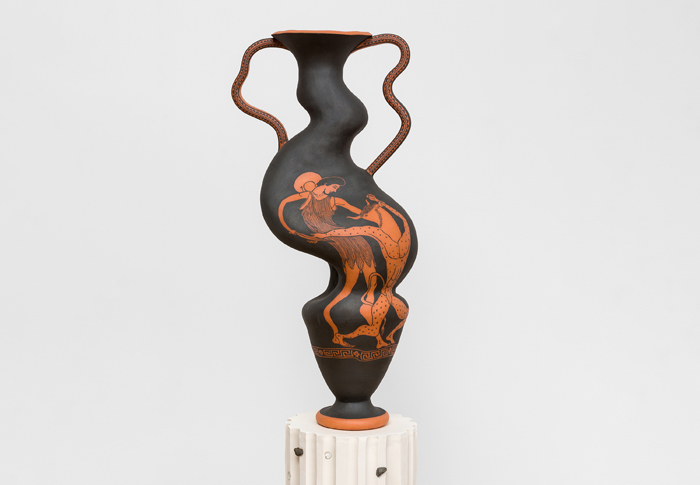
Shulamit Nazarian is pleased to present Monster in the Maze, an installation of new sculptures by Cammie Staros. The artist explores the tropes of classical art history and mythology by appropriating and transforming the visual language of Greco-Roman architecture and artifacts. For her third solo exhibition with the gallery, Staros has designed a site-specific labyrinth of gallery walls to contain three new bodies of work: ceramic vessels, stone sculptures, and tapestries of hand-made ceramic coins. The exhibition’s installation alludes to the labyrinth of Greek myth as well as the maze-like quality of encyclopedic museums. By juxtaposing the storytelling structure of museums and myths, Staros makes space for us to question these institutions as sources of insight that blur the lines between truth and fiction.
In addition to calling on the museum as a source of knowledge, the exhibition’s title, Monster in the Maze, alludes to the iconic figure of the Minotaur, a man with the head of a bull, as a cultural locus that invokes issues of nature and humanity, identity and otherness, and desire and violence. Art and literature featuring the Minotaur are ubiquitous and diverse—the story and its characters have fascinated countless creators, from Dante Alighieri’s medieval epic to the Surrealist movement of the 1930s, to the mid-century English novels of Mary Renault. Across these manifold cultural interpretations, the Minotaur is sometimes figured as a terrifying product of unnatural desire and sometimes a tragic antihero imprisoned by an unjust society. As established in the writings of Ovid and Virgil, the Cretan King Minos prayed to the sea god Poseidon to send him a snow- white bull as a sign of favor. When Minos failed to sacrifice the bull, Poseidon punished Minos by making his wife, Pasiphaë, fall hopelessly in love with the animal. The Minotaur was the monstrous, hybrid product of their love-making, a ferocious creature who required annual human sacrifices. Minos commissioned an inescapable labyrinth to contain the beast, turning his source of shame into a force of gruesome power.
Staros’s labyrinthine exhibition alludes to the legacy of the Minoan story in poetic and multiplicitous ways. Like the Minotaur at its heart, the labyrinth has been a potent carrier of metaphor. For the Surrealists, the labyrinth symbolized dream states—traversing the esoteric maze of the unconscious was the fantastic journey necessary to access the untamed center of the human mind. For Staros, the exhibition’s labyrinth also alludes to the principles of organization and display that characterize museums’ approach to remnants of ancient culture. As institutions steeped in the history of colonial exploitation, so-called “encyclopedic” museums traditionally construct a maze of different wings to house the relics of various cultures and time periods. Staros’s artistic practice considers the ways that the structures and ideologies of museum display shape the narrative of archaeologic objects by recontextualizing them to fit a particular story about history and art. Staros’s methods of display ask viewers to consider how institutions shape the meaning of cultural objects by displacing them from the flow of life and suggest the conceptual links between museums and mausoleums.
The exhibition comprises three types of objects that refer to traditional categories of Greek artifacts featured in museums: vessels, coins, and marble sculptures. The terracotta vessels draw their form from ancient red and black amphorae, Greek or Roman handled jars, and feature warped and morphed figurative scenes of warriors, gods, and animals hand-painted by Staros. While the artist has used slip-painting on her ceramic vessels before, this exhibition features the first body of work to feature recognizable narrative scenes, including images of the Minotaur, Poseidon, Theseus, and Athena.
The “coins” in the exhibition are ceramic forms made from numismatic molds, their red earthenware glazed in shades of blue and green, with silver and gold luster to evoke the tones of ancient, corroded treasure. The coins are linked with jewelry hardware and strung into wall hangings adorned with delicate spider webs made from thin silver chains, suggesting the fragile economic lifeblood and moldering remains of bygone empires.
The stone sculptures, carved from cream travertine, present fragments of bodies, their elegant posture contorted by the artist’s digital and physical manipulations. The color of the travertine and the image of fractured bodies evokes the skeletal remains of the Minotaur’s victims. Like the amphorae, Staros draws the forms of these works from specific sculptures from the Archaic period (circa 650–480 BC) but distorts and glitches them to appear as if viewed through moving water, or melted in a wave of destructive heat.
Together, these artifacts link ancient past and ominous present, portending a posthuman world in which artworks outlive their creators and become esoteric relics lingering amidst ecological destruction. Finally, the Minotaur also alludes to the “bull-headed” stubbornness of contemporary culture and our refusal to accommodate the inevitable encroachment of climate change and natural disaster. At the center of the labyrinth, visitors encounter a provocation to consider their own relation to the artwork on view, and to wonder if monstrosity is, perhaps, a matter of perspective.
